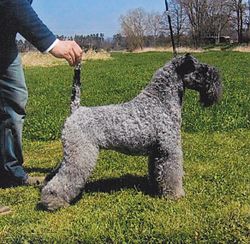Kerry Blue Terrier
Dog breed From Wikipedia, the free encyclopedia
The Kerry Blue Terrier (also known as the Irish Blue Terrier) (Irish: An Brocaire Gorm) is a breed of dog.[1] Originally bred to control vermin including rats, rabbits, badgers, ferrets, foxes, otters, hares, deer, and even wolves, over time the Kerry became a general working dog used for a variety of jobs including herding cattle and sheep. Despite a Kerry Blue winning Crufts (the most prestigious UK dog show) in 2000,[2] it remains an "unfashionable" breed,[3] and is distinctly uncommon; however, it is not as threatened as some of the other terrier breeds such as the Skye Terrier, Sealyham Terrier, and Dandie Dinmont Terrier.
| Kerry Blue Terrier | |||||||||||||||||
|---|---|---|---|---|---|---|---|---|---|---|---|---|---|---|---|---|---|
 A Kerry Blue Terrier | |||||||||||||||||
| Other names | Irish Blue Terrier | ||||||||||||||||
| Common nicknames | Kerry | ||||||||||||||||
| Origin | Ireland | ||||||||||||||||
| |||||||||||||||||
| |||||||||||||||||
| Dog (domestic dog) | |||||||||||||||||
Description
Summarize
Perspective
Appearance

Some characteristics of the Kerry Blue Terrier include a long head, flat skull, deep chest, and a soft wavy-to-curly coat that comes in several shades of "blue", the general term outside this breed being progressive grey. Puppies are born black; the blue appears gradually as the puppy grows older, usually up to 2 years of age. The male Kerry Blue is usually 46–48 cm (18–19 in) tall at the withers and weighs 12–15 kg (26–33 lb), while the female is usually 44–46 cm (17–18 in) and 10–13 kg (22–29 lb).[1]
Coat
The coat is the key feature of the Kerry. It is soft and wavy with no undercoat. The texture feels like a combination of fine human hair and wool. It does not shed but continues to grow throughout the year. This means the Kerry Blue requires very regular grooming (at least once per week) and clipping an average of every 6 weeks.[4]
Temperament
Kerry Blue Terriers are strong-minded and highly spirited. They have always been loyal and affectionate towards their owners and very gentle towards children but were often considered hostile toward other animals, including other dogs.[citation needed] If they are socialised with other dogs this is no longer the case.[citation needed] In the early days of competitive dog showing, the Irish Kennel Club required Kerries had to pass a "gameness" test, known as Teastas Mor certification, before they were deemed worthy of being judged.[5] These tests included catching rabbits and bringing a badger to bay in its set. They are fast, strong, and intelligent, and they do well in obedience, dog agility, sheep herding, and tracking.[citation needed] They have been used as police dogs in Ireland. Modern breeders have attempted to retain high spirits whilst breeding out aggression.[citation needed]
Health

Spiculosis is a painful condition that causes follicular hyperkeratosis.[6][7] This condition is only found in the Kerry Blue Terrier.[8] The breed is predisposed to footpad keratosis and hair follicle tumors.[8]
A 2024 UK study found a life expectancy of 12.4 years for the breed compared to an average of 12.7 for purebreeds and 12 for crossbreeds.[9]
History
Summarize
Perspective
The first literary reference to probably the Kerry Blue dates to 1847, when the author describes a dog that is bluish slate in colour, marked with darker blotches and patches, and often with black about the legs and muzzle.[10] The Kerry Blue Terrier was first observed in the mountains of Kerry in Ireland, hence the name of the breed.[4]
There is a romantic story of a blue dog swimming ashore from a shipwreck: the coat of this dog was so lovely that it was mated with all the female Wheaten Terriers in Kerry (or in all Ireland, according to some), producing the Kerry Blue. Perhaps this story is not entirely myth, as the Portuguese Water Dog is often suggested as part of the Kerry's makeup. Others suggest the Kerry was produced by the Soft Coated Wheaten Terrier crossed with the Bedlington Terrier with (or without) some Irish Wolfhound or Irish Terrier blood. The extinct Gadhar herding dog is also mentioned as another possible branch of the Kerry's family tree. The breed became very popular as an all-around farm dog in rural Ireland.[citation needed]
National Dog of Ireland
With the development of dog shows in the late 19th and early 20th centuries, the breed became standardised and "tidied up" for the show ring. The Irish nationalist leader Michael Collins owned a famous Kerry Blue named Convict 224. Collins even made an attempt to have the Kerry Blue adopted as the national dog of Ireland.[11]
The first show of the Dublin Irish Blue Terrier Club took place outside official curfew hours and was entered both by those fighting for and against an Irish republic. The Dublin Irish Blue Terrier Club was so successful it led directly to the foundation of the Irish Kennel Club, and a Kerry Blue was the first dog that club registered.[citation needed]
See also
References
External links
Wikiwand - on
Seamless Wikipedia browsing. On steroids.
